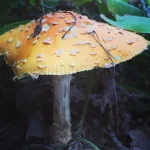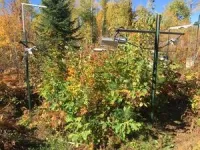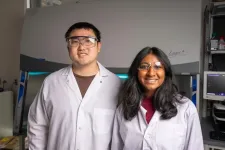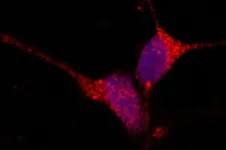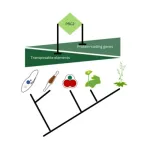(Press-News.org) Children are taught to leave wild mushrooms alone because of their potential to be poisonous. But trees on the other hand depend on fungi for their well-being. Look no further than ectomycorrhizal fungi, which are organisms that colonize the roots of many tree species where the boreal ecosystem (zone encompassing Earth’s northernmost forests) and the temperate ecosystem (zone between the tropical and boreal regions) meet. This area features a mix of boreal trees including needle-leaved evergreens and temperate tree species including maple and oak.
Just like a healthy human relationship, trees and fungi work well together because they help one another. When the ectomycorrhizal fungi attach themselves to tree roots, they acquire carbon in the form of sugars from their tree hosts and in turn provide the trees with important nutrients like nitrogen and phosphorous. It’s an important symbiotic relationship that drives ecosystem function and resilience.
But as climate change and global warming cause higher temperatures and amplified drought, little is known about how these important fungi will respond. Additionally, there are lingering questions about how climate warming will impact the underground threads – known as ectomycorrhizal networks - formed by fungi that connects trees and facilitates the transfer of water, nitrogen and other minerals.
To investigate this issue, a research team from Syracuse University and the University of Minnesota conducted a climate change experiment where they exposed boreal and temperate tree species to warming and drought treatments to better understand how fungi and their tree hosts respond to environmental changes.
The study, led by Christopher W. Fernandez, assistant professor of biology in Syracuse University’s College of Arts and Sciences, was recently published in the journal Proceedings of the National Academy of Sciences (PNAS). Their findings revealed that the combined effects of warming and water stress will likely result in major disturbances of ectomycorrhizal networks and may harm forest resilience and function.
The team conducted their work at a long-term climate change experiment called B4WARMED (Boreal Forest Warming at an Ecotone in Danger) in Minnesota. The experiment features plots where both boreal and temperate tree species have been planted and exposed to warming and drought treatments. This allows researchers to explore how the ectomycorrhizal fungi and the networks they form with their tree hosts respond to environmental stressors.
Fernandez, whose research aims to understand processes involving plant, microbial and ecosystem ecology, says their study revealed that composition of ectomycorrhizal fungal species changes dramatically with climate change. Specifically, they saw a shift from species commonly found in mature forests that have high biomass mycelium (the thread-like body of the fungus that explores the soil and that is likely important for network formation) towards low biomass species that are generally found in highly disturbed ecosystems.
“There is a supported hypothesis that these low biomass species probably do not provide the host much benefit in terms of nutrition compared to high biomass species,” says Fernandez. “We found that the networks formed by these fungi that ‘connect’ the trees shifted from relatively complex and well-connected networks to ones that are simpler with less connections.”
Fungal mycelium is a network of thread-like tissue filaments that help plants and trees share nutrients. (Credit: Christopher Fernandez)
The authors say these shifts were significantly related to the performance of the tree hosts and their ability to convert carbon dioxide into oxygen and sugars through photosynthesis. “Climate change is reducing the amount of carbon the trees fix and likely has cascading effects on how much carbon they can provide to their ectomycorrhizal fungi,” continues Fernandez. “This is likely causing a shift towards low biomass species, resulting in the breakdown of networks between trees.”
The research team believes this to be the first study examining the response of ectomycorrhizal networks to climate change and their results should generate new research focusing on other ecosystems. Building on this work, they say the next step will be to link the changes in ectomycorrhizal networks to ecosystem level processes such as nutrient and carbon cycling to better understand how resilient they are to changing climate.
Full publication citation: Christopher W. Fernandez, Louis Mielke, Artur Stefanski, Raimundo Bermudez, Sarah E. Hobbie, Rebecca A. Montgomery, Peter B. Reich, Peter G. Kennedy; Climate change–induced stress disrupts ectomycorrhizal interaction networks at the boreal–temperate ecotone. PNAS August 2023; 120 (34): e2221619120. doi: https://doi.org/10.1073/pnas.2221619120
END
How climate warming could disrupt a deep-rooted relationship
Researchers from Syracuse University and the University of Minnesota find that warming trends will likely result in major disturbances of networks of fungi potentially harming forest resilience
2023-09-21
ELSE PRESS RELEASES FROM THIS DATE:
Split gene-editing tool offers greater precision
2023-09-21
HOUSTON – (Sept. 21, 2023) – To make a gene-editing tool more precise and easier to control, Rice University engineers split it into two pieces that only come back together when a third small molecule is added.
Researchers in the lab of chemical and biomolecular engineer Xue Sherry Gao created a CRISPR-based gene editor designed to target adenine ⎯ one of the four main DNA building blocks ⎯ that remains inactive when disassembled but kicks into gear once the binding molecule is added.
Compared to the intact original, the split editor is more precise and stays active for a narrower window of time, ...
Diamond materials as solar-powered electrodes - spectroscopy shows what's important
2023-09-21
It sounds like magic: photoelectrodes could convert the greenhouse gas CO2 back into methanol or N2 molecules into valuable fertiliser - using only the energy of sunlight. An HZB study has now shown that diamond materials are in principle suitable for such photoelectrodes. By combining X-ray spectroscopic techniques at BESSY II with other measurement methods, Tristan Petit's team has succeeded for the first time in precisely tracking which processes are excited by light as well as the crucial role of the surface of the diamond materials.
At first glance, lab-grown diamond materials ...
How do toxic proteins accumulate in Alzheimer’s and other diseases?
2023-09-21
Under normal circumstances, tau protein is part of the brain’s infrastructure, important for stabilizing neurons into their proper shapes. But sometimes tau gets knotted up into tangles and turns toxic, injuring brain tissue and causing tauopathies, a group of brain diseases characterized by problems with learning, memory and movement. Alzheimer’s disease is the most common tauopathy, but the group also includes Parkinson’s disease, chronic traumatic encephalopathy (CTE) and several rare genetic conditions.
In search of ways to prevent these destructive ...
Study details immune cells vital to success of vaccines against coronavirus
2023-09-21
A study has revealed new details about a key population of immune system cells critical to successful vaccination against the pandemic virus, SARS-CoV-2.
Led by researchers at NYU Grossman School of Medicine and New York Genome Center, the current study focused on T cells, which along with B cells, compose the human immune system’s response to invading viruses and bacteria. A subset of T cells, labeled with the surface protein CD8, produce molecules that directly kill infected cells. B cells produce antibody proteins that neutralize and label infected cells for removal from the body.
Without risking ...
University of Cincinnati research examines the molecular mechanism of psychological loss
2023-09-21
Psychological loss can occur when someone loses a job, loses a sense of control or safety or when a spouse dies. Such loss, which erodes well-being and negatively impacts quality of life, may be a common experience but little is known about the molecular process in the brain that occurs because of loss.
New research from the University of Cincinnati explores those mechanisms through a process known as enrichment removal (ER). The study highlights an area of the brain that plays a key role in psychological loss and identifies new molecular targets that may alleviate its impact.
The research was published in the journal Molecular Psychiatry.
The research was led by Marissa Smail, a ...
Cardiff University chooses Figshare as integral part of research data management strategy
2023-09-21
Digital Science, a technology company serving stakeholders across the research ecosystem, is pleased to announce that Cardiff University has chosen Figshare from Digital Science’s flagship products to enhance its researcher support services, as it continues its work as a leading research institution.
Cardiff University – already excelling in the production of high-quality, innovative research that translates into benefits for the city, Wales and worldwide – has signed a two-year deal to utilize Figshare as its data repository and to form an integral ...
MD Anderson Research Highlights for September 21, 2023
2023-09-21
HOUSTON ― The University of Texas MD Anderson Cancer Center’s Research Highlights showcases the latest breakthroughs in cancer care, research and prevention. These advances are made possible through seamless collaboration between MD Anderson’s world-leading clinicians and scientists, bringing discoveries from the lab to the clinic and back.
Understanding the role of exceptional research as a driving force behind progress in its mission to end cancer, MD Anderson is proud to support World Cancer Research Day, Sept. 24, which calls for global efforts to promote cancer ...
Incidence of diabetes among youth before and during the pandemic
2023-09-21
About The Study: In this study that included data from Kaiser Permanente Southern California of individuals age 19 and younger, the incidence of type 1 diabetes slightly increased overall and type 2 diabetes significantly increased after the beginning of the COVID-19 pandemic, in particular among non-Hispanic Black and Hispanic youth. These findings suggest the need for further evaluation of physiologic and behavioral risk factors preceding new-onset diabetes during the pandemic.
Authors: Matthew T. Mefford, Ph.D., of Kaiser Permanente Southern ...
Disparities in emergency medicine residents’ performance assessments by race, ethnicity, and sex
2023-09-21
About The Study: This analysis of assessments of 2,708 emergency medicine residents found evidence of sex-specific ethnoracial disparities in ratings on the Milestones assessments. These disparities increased over time across multiple Milestones assessments and were most severe for female residents of ethnoracial groups that are underrepresented in medicine.
Authors: Elle Lett, Ph.D., M.A., M.Biostat., of the University of Washington School of Public Health in Seattle, is the corresponding author.
To ...
New origin story for key regulatory gene
2023-09-21
Polycomb repressive complex 2 (PRC2) was discovered decades ago in Drosophila, where it was found to be a key controller of developmental genes. Further analyses showed that PRC2 modifies chromatin and silences target gene expression. However, the ancestral function of PRC2 - as functioning primarily to control genes during development - was called into question when researchers discovered that PRC2 also plays a role in unicellular species, in which no development takes place. A first hint at PRC2’s original role came from studies in red algae, which found PRC2 left its methylation mark on transposons – jumping genes that ...
LAST 30 PRESS RELEASES:
Injectable breast ‘implant’ offers alternative to traditional surgeries
Neuroscientists devise formulas to measure multilingualism
New prostate cancer trial seeks to reduce toxicity without sacrificing efficacy
Geometry shapes life
A CRISPR screen reveals many previously unrecognized genes required for brain development and a new neurodevelopmental disorder
Hot flush treatment has anti-breast cancer activity, study finds
Securing AI systems against growing cybersecurity threats
Longest observation of an active solar region
Why nail-biting, procrastination and other self-sabotaging behaviors are rooted in survival instincts
Regional variations in mechanical properties of porcine leptomeninges
Artificial empathy in therapy and healthcare: advancements in interpersonal interaction technologies
Why some brains switch gears more efficiently than others
UVA’s Jundong Li wins ICDM’S 2025 Tao Li Award for data mining, machine learning
UVA’s low-power, high-performance computer power player Mircea Stan earns National Academy of Inventors fellowship
Not playing by the rules: USU researcher explores filamentous algae dynamics in rivers
Do our body clocks influence our risk of dementia?
Anthropologists offer new evidence of bipedalism in long-debated fossil discovery
Safer receipt paper from wood
Dosage-sensitive genes suggest no whole-genome duplications in ancestral angiosperm
First ancient human herpesvirus genomes document their deep history with humans
Why Some Bacteria Survive Antibiotics and How to Stop Them - New study reveals that bacteria can survive antibiotic treatment through two fundamentally different “shutdown modes”
UCLA study links scar healing to dangerous placenta condition
CHANGE-seq-BE finds off-target changes in the genome from base editors
The Journal of Nuclear Medicine Ahead-of-Print Tip Sheet: January 2, 2026
Delayed or absent first dose of measles, mumps, and rubella vaccination
Trends in US preterm birth rates by household income and race and ethnicity
Study identifies potential biomarker linked to progression and brain inflammation in multiple sclerosis
Many mothers in Norway do not show up for postnatal check-ups
Researchers want to find out why quick clay is so unstable
Superradiant spins show teamwork at the quantum scale
[Press-News.org] How climate warming could disrupt a deep-rooted relationshipResearchers from Syracuse University and the University of Minnesota find that warming trends will likely result in major disturbances of networks of fungi potentially harming forest resilience
